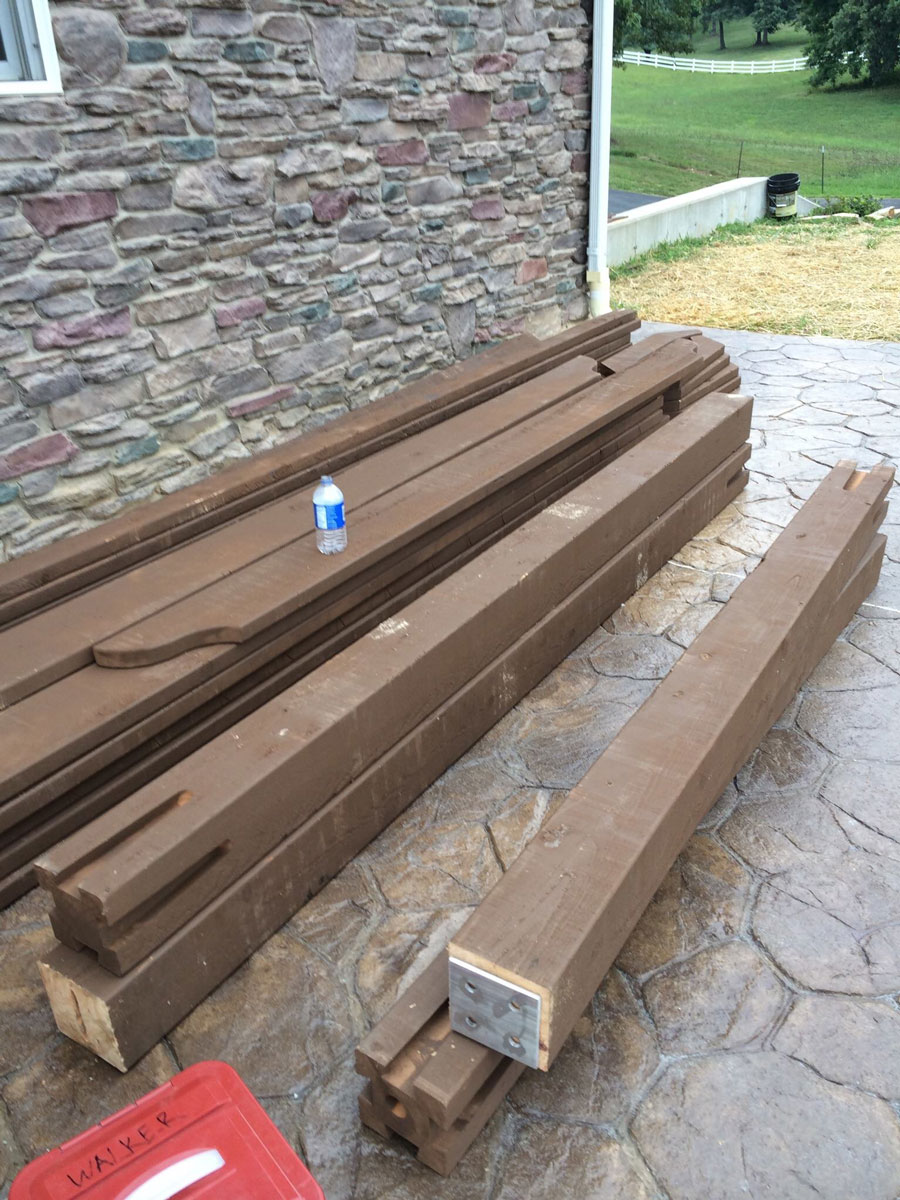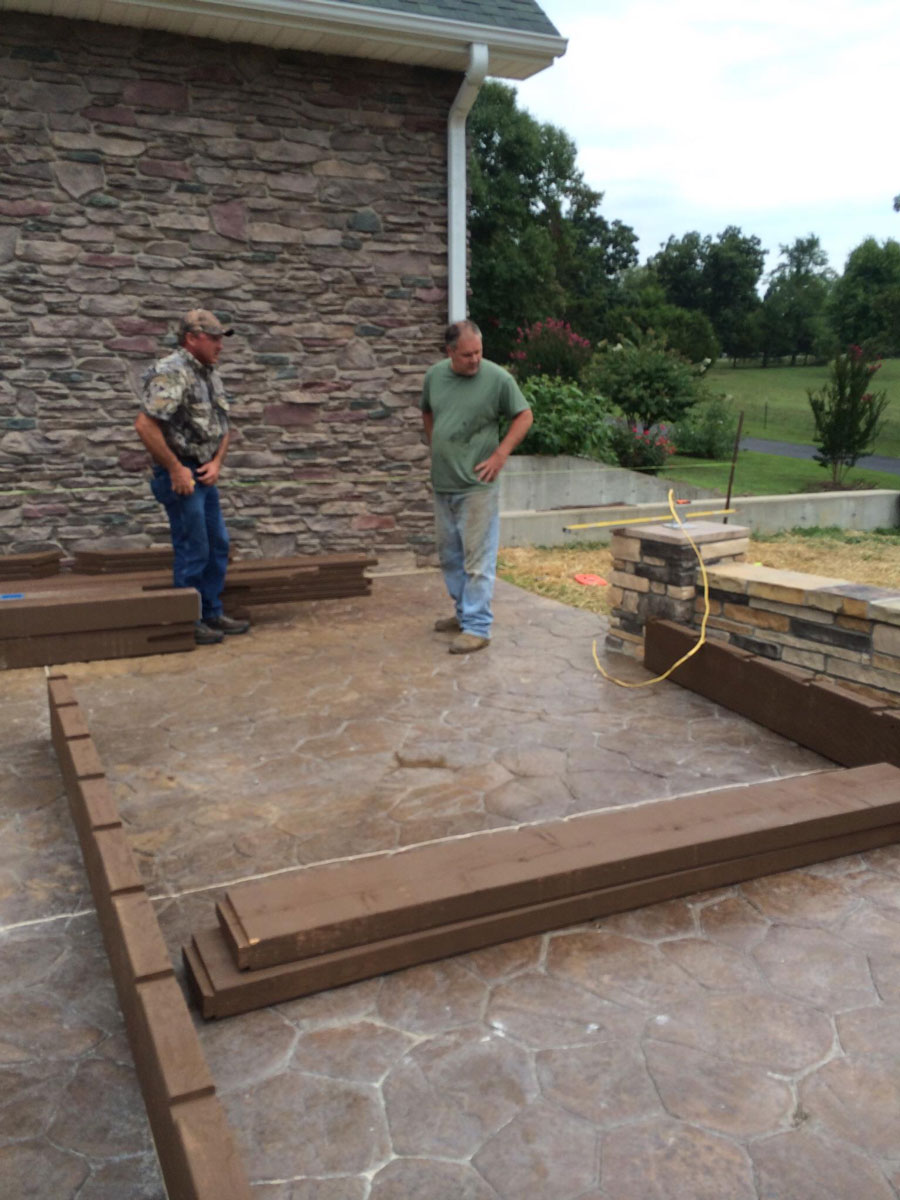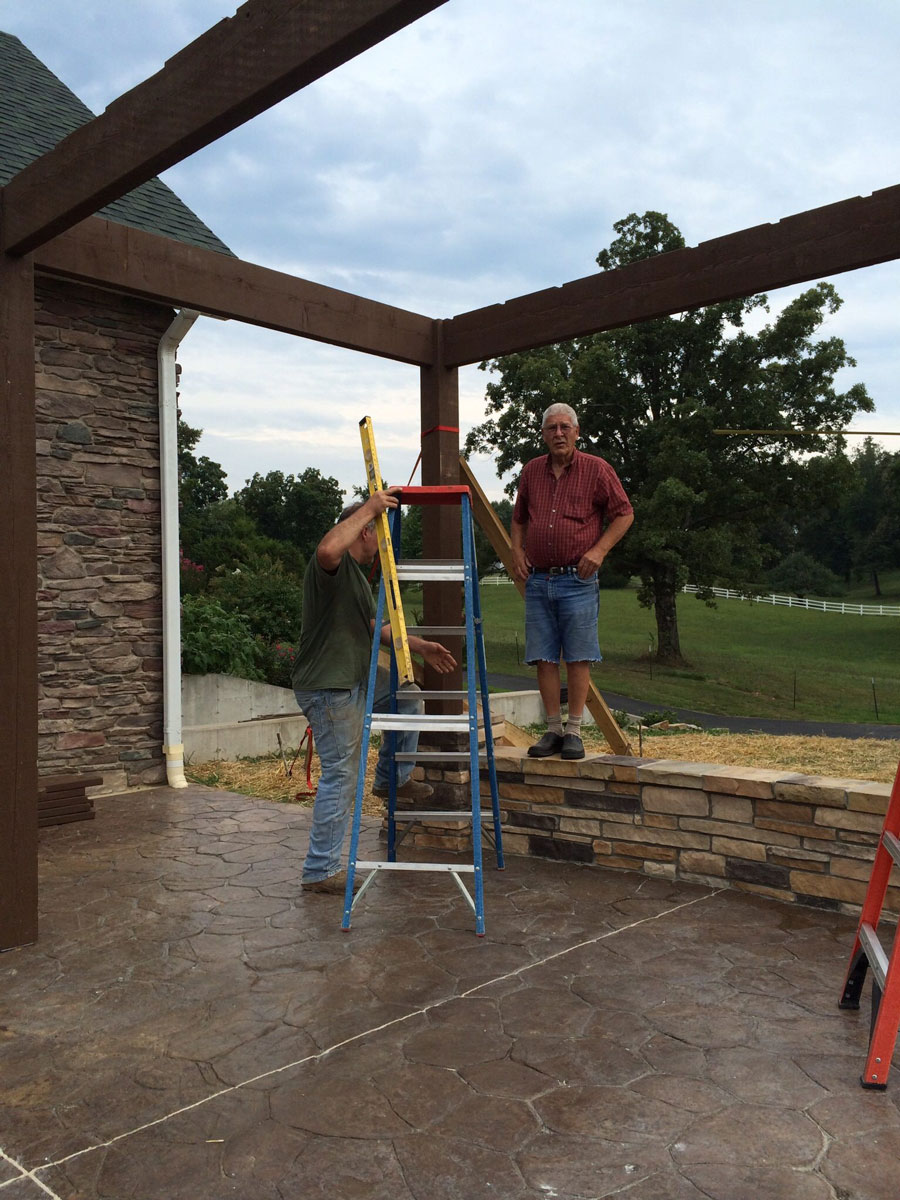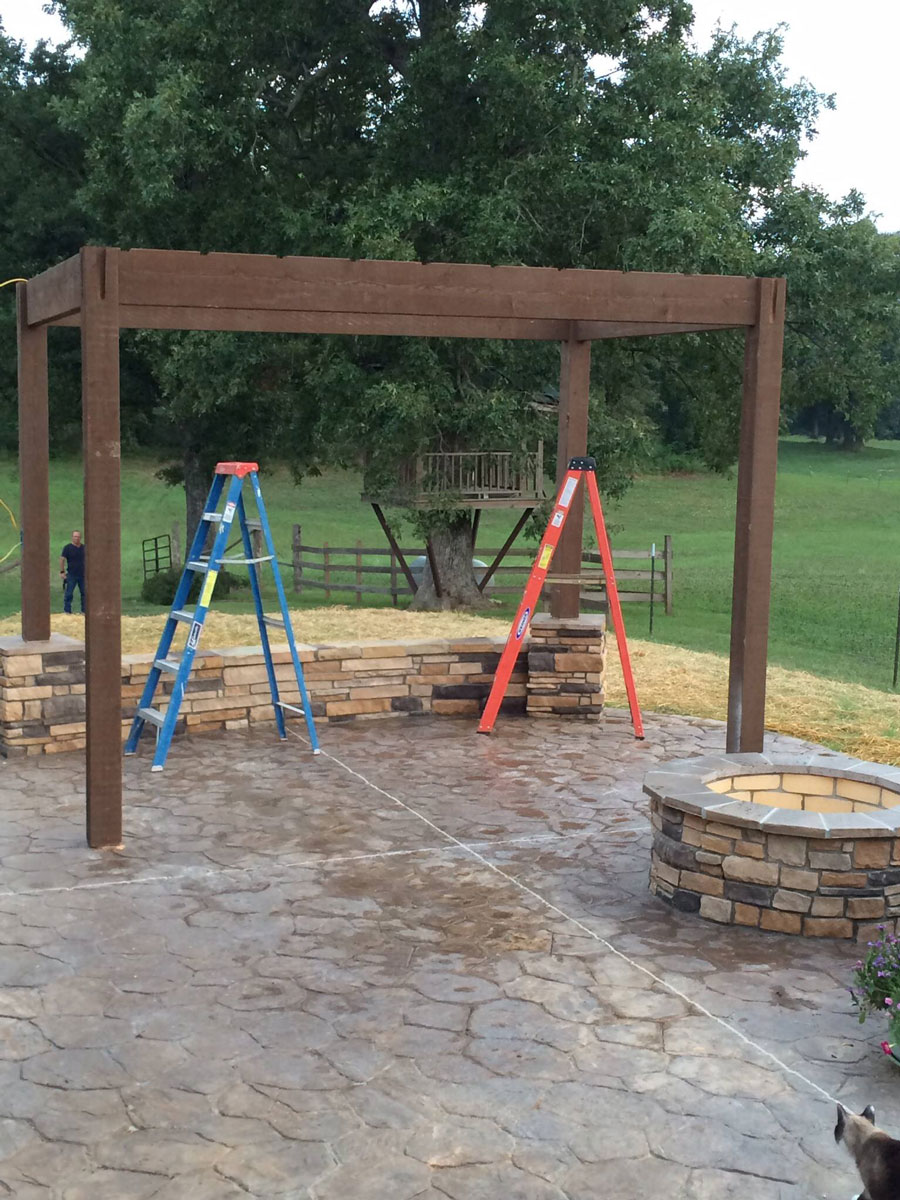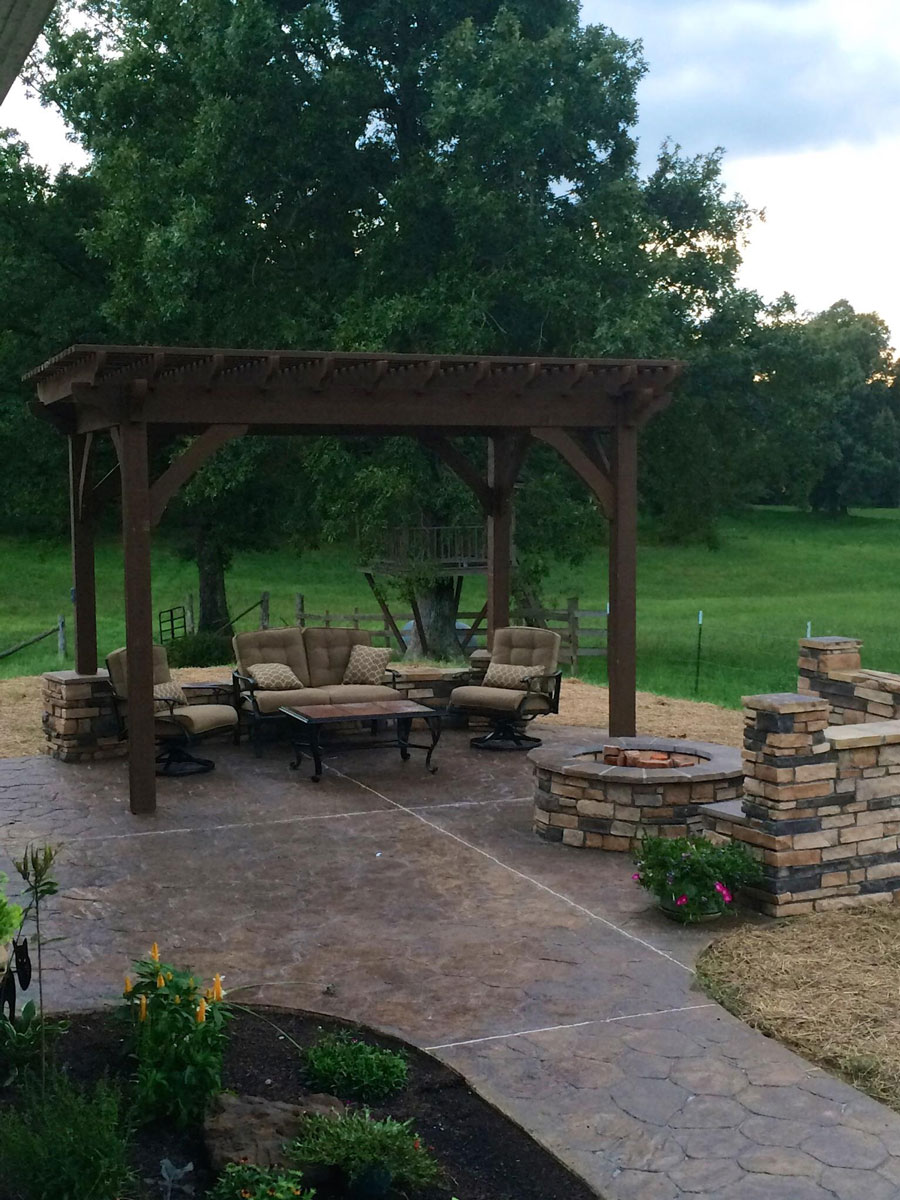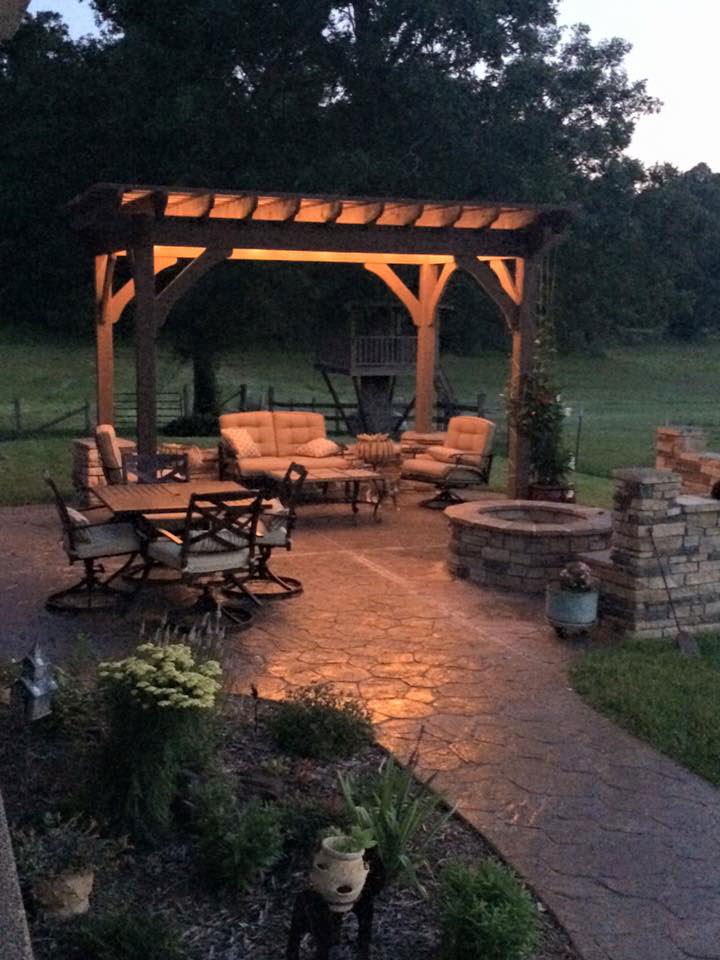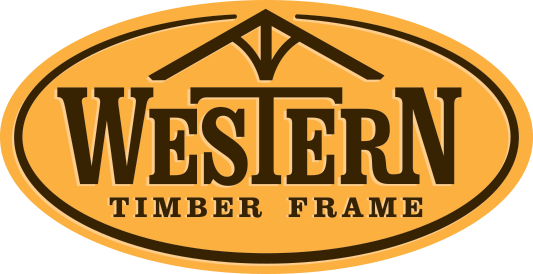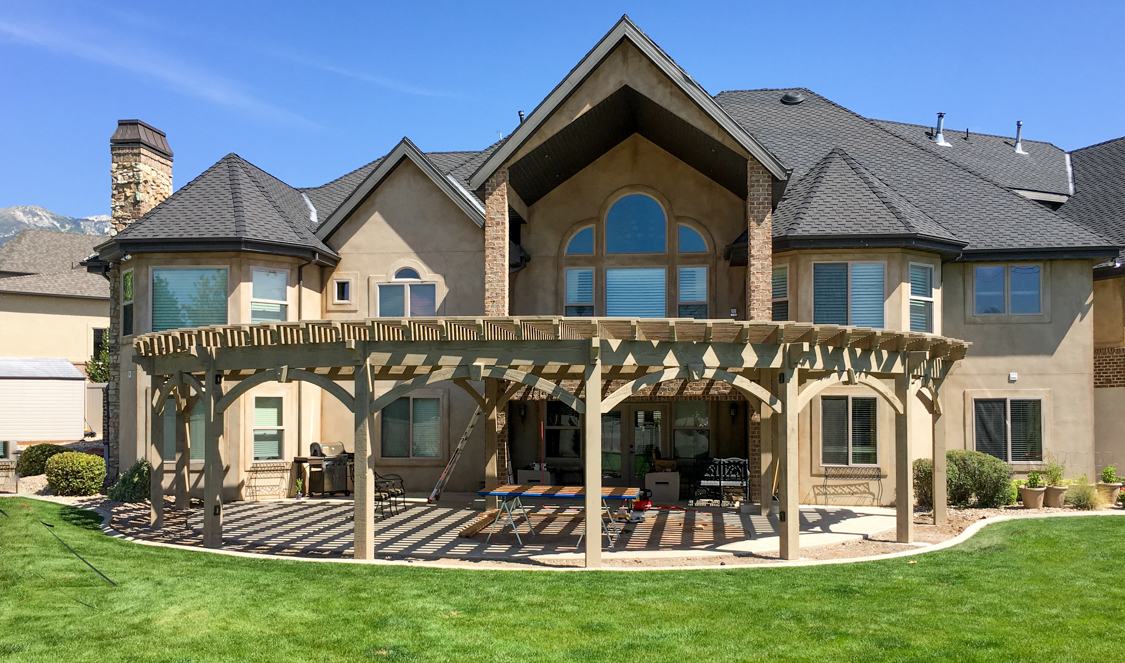
Please take the time to watch each video in this series.
Please do not skip through them.
They need to be watched in order and in their entirety to make sure no steps are missed in the installation procedure.
Pergola Kit Installation Time Lapse
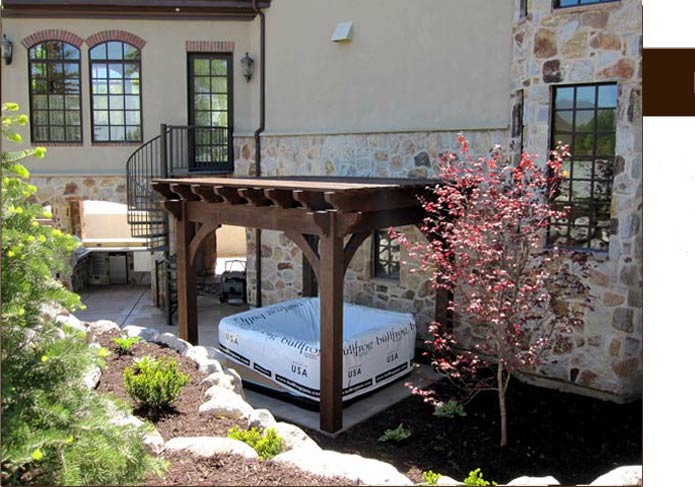
4 men + 2 hrs 6 min = WOW!
First, get your pergola kit. We suggest laying it out on either some grass or putting some two-by-fours under it if you’re going to lay it on some concrete.
Sometimes the stain is still a little bit wet; a little bit tacky, and so for respect for our clients we stick it up off the ground on some 2x4s.
Just lay it all out so you have all your parts and pieces and make sure there are not any major problems or issues with the wood, anything is broken.
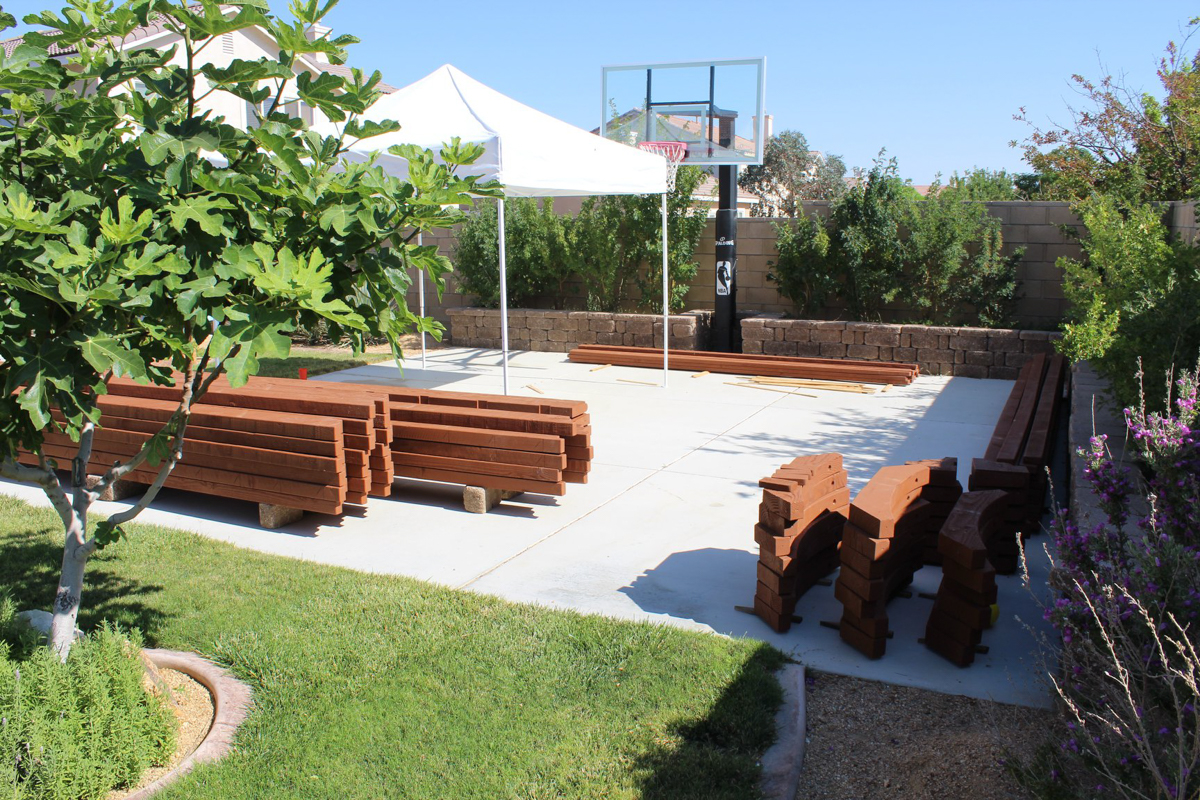
Keep in mind that there are natural defects in the wood even though we use number one appearance grade timber, you will still always have minor things that are minor flaws in the wood because it is raw timber roughs on the timber so double check that and make sure that you are not missing any parts.
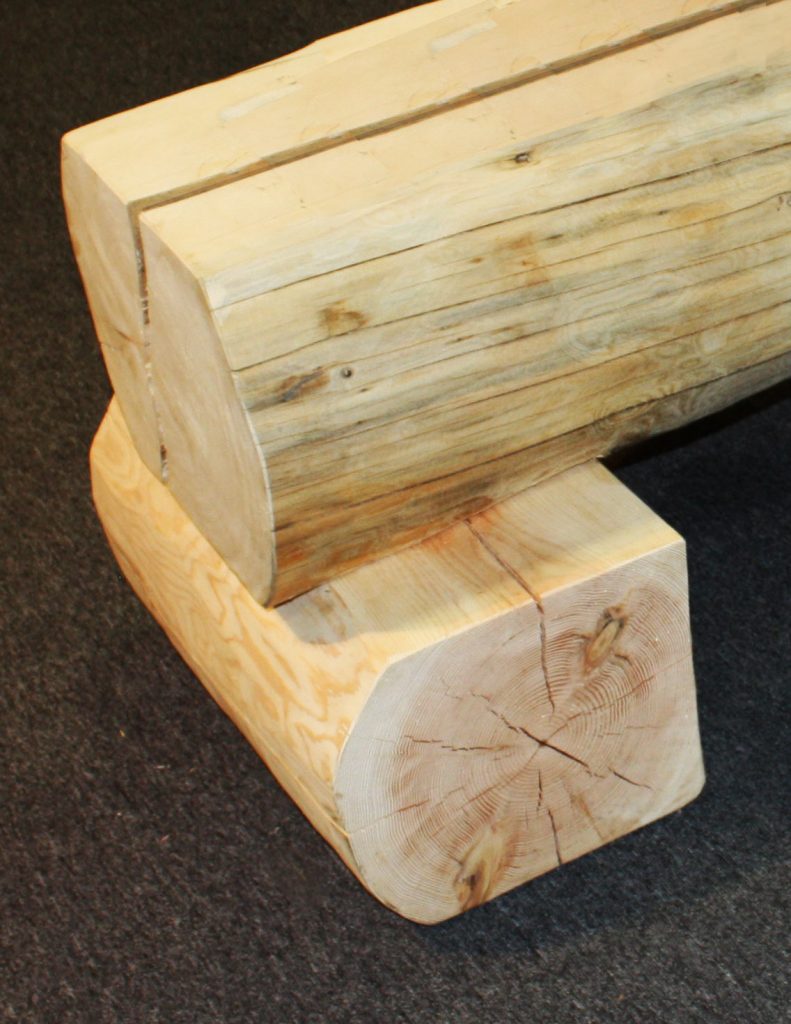
2 of 12 Video Transcript: Prep and Getting Started
Another thing to consider when you are laying out all of your timber and just reviewing it making sure every part and piece is there, you are going to notice that there is typically going to be three rafters that have markings on the top. Those markings are the layouts for your 2×6’s or 2×4’s top shade flanks. So this here would be the outside markings up to the two by six with the x in the middle. That is going to be the first two by six on the ends and then we’ve got a mark, then we have a straight line, and layout to go, layout go, layout goes all the way down.
So we send out three of these so you can put one on each end and put one in the middle, that will help you to know where to screw your 2x6s down. It will also help you to keep them straight. Sometimes the 2x4s and 2x6s will come out a little bit crooked because they’ve been a little bit from the time they have been manufactured until the time they are installed they may have warped just a little bit to be natural wood and then those layouts are going to help keep them straight.
Here are the posts. Here you will notice that there is also some minor defects on some of the posts – and even as much as just little nicks and dings that may be in the raw timber.
Another thing to keep in mind that even though this is dark and nice; a beautiful piece of wood here in these posts, it will, as it is outside, begin to check a little bit, begin to have a little bit of surface cracking. It will start to open up and show the unstained wood beneath. So, you’ll have things like this that will begin to open up just a little bit. It is completely normal and it will come to a point that it won’t open up anymore but by the time you come to the next coat of stain you put on it, it will completely go away.
We’ll show some further pictures on that or look at the video on checking. You will also notice in most cases if you have a standard pergola kit, we’ve got to load beams that will have rafter layouts already notched in for you. That’s going to help keep it convenient for the layout to already be there. You’ll just drop the rafters in those layouts and make sure you have the proper overhang on each end. Then you’ll be able to fasten the rafters down to the posts to these lower support beams.
The other reason for these notches is it’s going to help the rafter to not, the bottom of the rafter to not warp or twist out as much either.
3 of 12 Video Transcript: Square Up Your Pergola
Now we are going to square up this concrete patio. Measure the pad. It is just over ten feet from our post to post is going to be 9 foot 10, outside to outside, so it is going to come in about 1 ¾” from each side. Make our marks here and then get a square-up the patio there.
Once we get a couple of marks we use a PLS laser that will shoot a 90 degree (or you can use the simple Pythagorean formula or you can just do the math for the 3, 4, 5, method. A squared + B squared = C squared. Laser going to the most accurate and quickest especially if you are going to go around the hot tub and you can’t get a corner to corner dimension.
If you are ever in doubt on exactly where to place the posts, you can measure just the edge of the load beam. Not the dovetail but this edge down to another one here. That’s going to tell you exactly what your dimension is between the posts.
4 of 12 Video Transcript: Knife Plate Layout
Once you get your posts layout mark, I would mark out, this is going to be for 8″ posts so I would mark out 8″ all the way around so that your inside and outside posts are marked out.
Then we would take the steel or in some cases aluminum knife plate. These are 100% aluminum. This is typically what we use. In some cases, we’ll need to use structural steel and you’ll end up centering it in the post layout mark then you can begin to mark for your posts here and then eventually put your two concrete bolts.
Either put them kitty-corner or in a case like this I would put them here and here so that we are not doing it on the corner of the concrete here.
Once you’ve got all 4 posts laid out, the next thing you’ll want to do it is to get a height for each post.
Your concrete is going to have some slope so we’ve set up the laser here on one corner. We are going to shoot and use that corner as 0 and shoot each post and get a height. We’ll see where the laser is there and then we’ll go through and shoot the heights for each post.
Here we’ve created a little map of where and numbered and we are going to number each post, 1. 2. 3. 4 and make our marks. Which posts is ¼” high, ¼” low, whatever it may be where we are going to be cutting off 1” or 2” per post.
Here we’ve laid out our posts and numbered each one to correlate with the numbers on the map of where the posts are going to go and then we’ve got this one here that’s been drilled for power. I’ll actually end up putting a switch here in the center as well so keep that in mind and number your posts to correlate with the map that you’ve made.
Once you’ve got your plate laid out there and centered, go ahead and drill two holes. We wouldn’t need to drill all 4 but we would do the two holes Kittycorner. Probably stay away from the corner as much as possible in case the post that’s being installed is right on the edge of the concrete. We would stay away and do the holes kitty-corner.
We suggest when you mark out for these knife plates that can either make a mark with a sharpie on the concrete and drill or leave your knife plate exactly where it is going to sit and stand on the corner so it doesn’t move as you drill. So we get the holes drilled and we’ll be able to go ahead and pound these down into where they are nice and snug and then we’ll end up taking a crescent wrench and tightening these up once they have been pounded down all the way.
Now that we’ve pounded them down tight we just tighten them up with a crescent wrench and then we’ll show you next what we’re going to do with these bolts that are sticking out cause we can’t set our posts on those, the next step on cutting the posts and then knocking out for those bolts there, the redheads and the nuts.
5 of 12 Video Transcript: Prep For Posts
Now we’ve got our posts laid out here and our map complete. We’ve drawn up here in the house. The critical post is number 4 because it has power drilled through it and so that’s one we want to watch.
So we’ve numbered them 1, 2, 3, 4. This here was the highest post and so we’ve started with that one. You can see just minus a 1/8th off of each additional post and 42 7/8th is considered 0 and we just minus a 1/8th per post around. We’ve already marked our posts here. We’ve got down and this one is set at 9’ so this is post 1 and we go 9’ and then the next which is post 2 with just minus a 1/8th and so on with the other two with a 1/8th off.
One thing to keep in mind is which direction the knife blade is going. Sometimes it will be crucial to make sure you are installing your knife plate in the same direction that it’s precut for you.
You notice here that we get the general height and how tall your pergola is going to be and we will leave about a 1 ½” to 2” each post; leave that much longer so that you can have a little bit to cut off to vary for your sloping concrete.
The only reason we cut these off at a different height for each one is just to ensure that the top of the roof is perfectly level.
We’ll show you here the way we cut the posts to give it the best cut obviously come down one side first and then drop down the other side to give it a nice clean cut. We decided to use in this case an electric chain saw or we also use the gas chain saws, either way. We use the teeth on the back of the blade there to grip into the post to help you cut nice and straight.
Once your post is cut to length, you’ve also noticed that we have already mortised the knife plate for you; mortised the posts. For each knife plate where the blade comes down, we’ve got a weld bead on both sides; we just need to accommodate for that so we’re just going to notch that out just a little bit more to accommodate that weld bead there.
Okay, then once that’s done we’ll take a knife plate and we’ll put the knife plate in and just be sure that it’s going to fit. Sometimes you have to mortise it out just a little bit more. We’ll just put the knife plate in before it’s bolted in the concrete, just to slide it up and down just to make sure it can fit in there completely and still be centered around the post. That looks good.
K, once we’re ready to put the knife plate up and center it on the post then we mark each hole where the bolt is going to be and then we are going to go ahead and predrill those marks so that it can drop right over the concrete bolt directly onto the knife plate.
This hole down here is for the power and this one will be for the bolt. Right now we are using a 1 ¼” recess bit there. Once we get all this recessed we send out some touch-up stain; we drop a little shirt or something under so we don’t get it on the concrete and then we take some of that touch-up stain and then just stain up the bottom of the posts and it seals up the bottom as well. We get that all stained up so it’s completely done and you will be ready to stand.
6 of 12 Video Transcript: Setting The Posts
You can see how the post is setting over the knife plate itself and then you don’t see the knife plate. So here’s the final post going up; we’ve made sure that everything’s drilled ready to go and it just drops right over the knife plate.
(Setting the beam posts) So we lift the posts up over. They just lockdown in with the dovetail. (Setting the beams flush with the top) Once your posts and beam extensions are up, you just take a rubber mallet and just pound them down. Pound them down nice and tight just so they are flush with the top of the posts. Then we’ve already got each post and each beam pre-drilled for a fit.
We make sure that the beam and extension that the mallet is on is in line with the layouts so that you’re not putting the wrong 12” beam extension on the opposite side of the rafter layouts. Then we end up taking the lag we provide and go ahead and put those in. Notice all the lags and bolting is done up above where it is not in the view of the finished project.
7 of 12 Video Transcript: Fastening Beams & Rafters
We’ll put a bolt through. Once all four corners are done then we will be ready for the layup to get all the posts leveled. You notice we are already getting some temporary 2×4’s tracked to the upper beam. (make sure all the posts are plumb, square and level)
8 of 12 Video Transcript: Setting The Knee Braces
We are ready to put the knee braces up. (Track on the knee braces with a 3” screw) We have a 3” screw tack screw to tack it on initially. Hold it and center it up on the place there and put the 3” tack screw in.
That’s just going to really hold it in place till we are ready to put the lag in. The holes we have plugs for them as well. (Remove the level bracing)
Once all the knee braces are tacked and you got the lags and got them plugged now we can take off the temporary braces here. (Lag the knee braces) Now that all the knee braces are tacked on here we’ll go ahead and lag them. Make sure the knee braces are square and straight.
If your kit has been sitting for a while before you install it after it is delivered, one thing you may want to check is that the long cut at the top or the sides of the knee braces may need to be trimmed just a little bit.
The other reason that would occur, if this wasn’t completely tight would probably be an indicator of your posts wasn’t completely level. As long as you are keeping everything square (plumb).
When putting in the plugs use a smooth head hammer and go ahead and pound in your plugs, if you use a hefty waffle it is going to mark things up. Once they are plugged on both sides, we will go ahead and touch them up with some of the stains we sent out. We leave the plugs sticking out about a ¼”.
9 of 12 Video Transcript: Setting Roof Rafters
Once we get the rafters set, right now they are all just laying down, we want to make sure that you’ve got the layouts on the end here. We’ve made a mark here to where it slides over, flush to this beam. On this one here we are going 14” past. Yours maybe 12”.
We’ve just got a layout mark we’ve got there and then it sits right there down into this notch and then we do a tack that’s going to hold the bottom You can see it sitting down in the notch layout.
The layout notch is going to help reduce the bottom of it twisting out so the top we are going to have all the 2×6’s spaced 10” on center with 2 decking screws per 2×6. That really locks in the whole roof and gives it sheer value and because the roof isn’t going to be a solid covered roof, the 2×6’s is more of a lattice effect.
The wind is going to blow through it rather than have a lot of uplift or else we would be fastening the rafters to the beams more securely with longer bolts for the top. (get all rafters on beams then stand them up and fasten)
You can see there at the top of the posts there (make sure layout rafters are on ends and in the middle) is the one we drilled for power. We’ve got all four lags into the posts. We’ve got our layout board here, our layout rafter on the end and then we’ve got the layout in the middle and layout in the end.
It looks like we are ready to do our 2×6. They are going to start pulling out and putting on each of these layouts. (Fasten top shade planks with two screws per plank per rafter) So here we’ve got the roof 2×6’s laid out. They are not all screwed down yet.
We’ll start over here on one side, make sure that the 2×6’s are equal hanging over the ends at equal distances, and then we’ll begin the fasten the 2×6’s with 2 decking screws per 2×6, per rafter. It really locks in the whole roof very well and that’s going to give it the sheer value and then the roof should be completed.
10 of 12 Video Transcript: Touch Up
Once the roof’s on we do a little bit of the touch-up for any of the nicks and any of the markings that happened during installation as it might need some additional touch-up. Just keep in mind that it’s normal if it ends up taking 45 minutes to an hour and a half to just walk through it, nice and neat again.
(Finished 12’ x 12’ hot tub pergola) Here we are with the pergola. We got it finished up, stained, and everything’s completed. You can walk underneath and notice that you do not see any lags, bolts, hangers, or hardware in the roof.
Everything’s done from up above. You’ve got that beautiful wood-to-wood connection on all the pieces and you can see how tight these joints are with this dovetail it has the wood and since it is outdoors it is going to do nothing but get tighter because it is a tapered beveled cut behind it.
We do put a final plaque on the post here so that if there is any questions or concerns or any additional information that is needed you can contact us at westerntimberframe.com. We’ve even got the post down the knife plates, you don’t see any of the steel or plates.
11 of 12 Video Transcript: Attached Pergola
This here is some of the natural checkings that occurs in the timber and then because it is outdoors, it is going to expand and contract a little bit.
The checking will begin to widen just a little bit and open up and you will be able to see the natural wood behind it that is not stained. Especially in this darker timber stain, you are going to notice it a lot more.
Just know that it is completely normal and you’ll probably see a little more on top of the upper beams but by the next time you go to re-stain the posts and beams then you won’t notice them anymore.
12 of 12 Video Transcript: Other Notes
So the biggest difference, most all other timber framers, is how they cut it out. This is how we used to cut it out in the very beginning. We would take a chainsaw and skill saw, and kind of hack out a “U” shape through the posts like on both sides even.
So, we would slide through like this here. We’d slide the other one through. We’d lock it in and then bolt it in which is great cause on day one if you’re really good you can get a pretty tight seam there but after two months, six months, you know, a year, two years you start getting a gap there. It is not wrong. It is just how it is.
Wood expands and contracts especially outside and these become so brittle, too, sometimes they break off and you have to screw them on. It just looks terrible. So, that’s pretty much how you’re going to get your timber frame kit or timber pergola and pavilions put together.
What we have done at Western Timber Frame™ is we have invested into the equipment where we actually do a dovetail, kind of a mortise notch on the beams and the tails there. On the posts, this is all the notching we do on the posts here. It still keeps the structural integrity of the posts in the center. You’ve just got the notch like that.
So even if this was a twenty-foot beam that you side in after you set the posts, lock in like that, you’ve got a tight seam there where you are not going to see the gap. Not if but when the wood expands and contracts outdoors, you’re not going to see it because it is behind this dovetail notch like that.
It is ultimately the difference between Western Timber Frame™ and what you are going to find across the country in pergola kits and in timber framing structures.
Example of DIY Pergola Kit by the Mullins Family of Kentucky
“We researched quite a few sites and talked to many people before investing in a Western Timber Frame pergola. What sold us was the dovetails! The ordering process was quite simple. It arrived in a nice bundle. We were able to put up our Western Timber Frame pergola with only 3 of us. It was amazingly simple.” — Teri Mullins
